Imagination Announces PowerVR Series7 GPUs - Series7XT & Series7XE
by Ryan Smith on November 10, 2014 8:50 AM EST- Posted in
- GPUs
- Mobile
- Imagination Technologies
- PowerVR
- PowerVR Series7
Series7XT In Detail
Now that we’ve had a chance to look at the common Series7 architecture, let’s take a look at the features and properties of Series7XT in particular.
Series7XT will be offered with 2 optional feature additions. The first is the aforementioned FP64 ALU, which is being offered as part of what Imagination is calling the HPC Feature Pack. As FP64 operations are not necessary for graphics work (and often even FP16 will do), the FP64 functionality is being offered to customers who want to build HPC hardware out of Series7XT. PowerVR hardware has up until now not been a competitor in the HPC space, so this marks a significant turning point for Imagination and would have them challenging frontrunner NVIDIA in this space. Also of note here, as the base 7XT configuration only supports OpenCL 1.2 Embedded Profile, the HPC pack upgrades 7XT’s OpenCL capabilities to 1.2 Full Profile.
Meanwhile the other optional feature pack for Series7XT is the Direct3D 11 pack, which is primarily geared towards customers who would be building Windows Phone and Windows RT devices. Imagination made Direct3D 11 an optional feature on 6XT, and is doing the same on 7XT. In the case of 6XT the D3D option would have added the necessary tessellation capabilities that are now default on 7XT, so for 7XT this is likely more about D3D features such as S3TC that require additional licensing.
Moving on, for as much as Imagination’s various enhancements ultimately improve performance, really it’s power efficiency that’s driving most of Imagination’s performance gains, and 7XT in turn is designed to further improve on Imagination’s power efficiency. Unfortunately Imagination isn’t throwing out any numbers here – just that 7XT can offer similar performance as 6XT for less power – but on the subject of power efficiency they have documented their efforts to deal with throttling.
To be clear here this is a matter ultimately in the hands of SoC integrators and is not something Imagination can directly control, but as a supplier they can offer advice and suggestions to their customers to improve the experience. Short of making PowerVR GPUs low power in the first place (and this is something everyone in this space tries to do), the next best thing they can do is to encourage customers to be mindful of throttling and to discourage designing their clockspeed governors to be bursty. While the “hurry up and go to sleep” motto makes a lot of sense for CPUs, it makes less sense for GPUs due to the fact that most workloads are sustained. By providing good real-time power usage data to the OS and by discouraging high maximum clockspeeds that lead to burst-and-throttle behavior from governors, for Series7 Imagination is at least trying to ensure that throttling is minimized.
Finally, Imagination has outlined the different configurations that Series7XT will be available in. Starting in 2 cluster configurations, 7XT scales up to 16 cluster configurations, or twice as large as 6XT. 2-4 cluster configurations are expected to be used in phones and TVs, meanwhile 6-8 cluster configurations are expected to be used in tablets, automotive, and ultrabooks. Finally the 16 cluster configuration would be targeted at non-traditional spaces for PowerVR products, such as full notebooks, dedicated (set-top) gaming devices, and servers. With a hefty 512 FP32 ALUs Imagination expects that the 16 cluster configuration should rival lower-end discrete GPUs, which would certainly be the competition for the device categories that Imagination is chasing.
Series7XE In Detail
Moving on, at the other end of the spectrum we have the Series7XE GPUs. These products are the successors to the Series6XE GPUs, and like their predecessors are focused on a narrower feature set for low cost devices, with an emphasis on area efficiency over power efficiency.
Of the Series7 features we’ve covered so far, Series7XE gains access to virtually all of those features. However a larger number of those features are optional and are not in the base configuration. Of note, all of the general enhancements for the frontends and the USC are carried over for the base configuration. However the tessellation block (and hence AEP support) is optional.
As a result 7XE has 4 optional feature packs to build on top of its base OpenGL ES 3.1 functionality. The AEP adds the tessellator and other AEP-centric functionality from 7XT that isn’t in 7XE’s default configuration. Meanwhile the Compression Pack segregates certain compression features from 7XE so that they’re only included in designs that need them (since SoC manufacturers may want to use 3rd party compression technology). HEVC and 10-bit YUV support is also optional for 7XE, and finally the virtualization features we discussed earlier are optional as well.
Since 7XT is targeted at 2 cluster and above configurations, 7XE is designed to cover the 1 and ½ cluster configurations. This results in 2 configurations, the GE7800 which implements a full cluster, and the GE7400 which implements a half-cluster. With the 1 cluster configuration targeted at low-end phones and TVs, the half-cluster configuration will be in the cheapest and simplest devices, along with being a candidate for high-end wearable devices.
Imagination says that at the low clockspeeds they’re envisioning for 7XE wearables, the full load power for the GPU would be under 1W, with low/idle power consumption of course being much lower yet. Any kind of power consumption approaching 1W definitely also approaches a “high-end” niche for wearables, but none the less it is viable if for any reason someone needed to build a wearable device that could handle OpenGL ES 3.1 graphics.


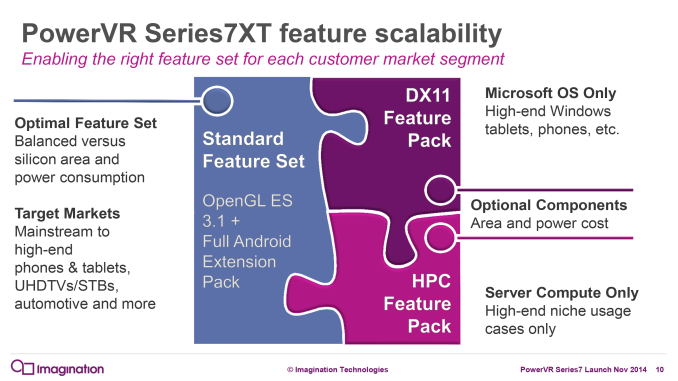
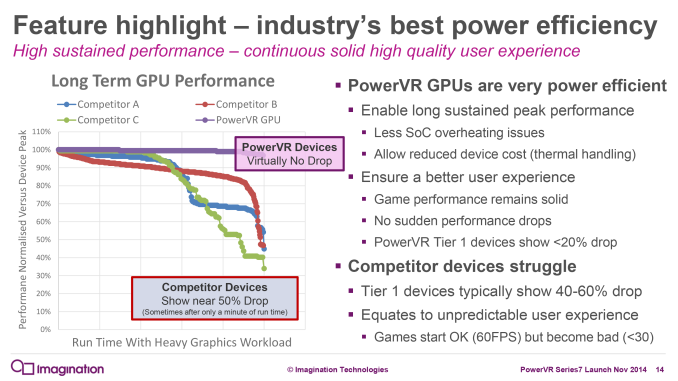
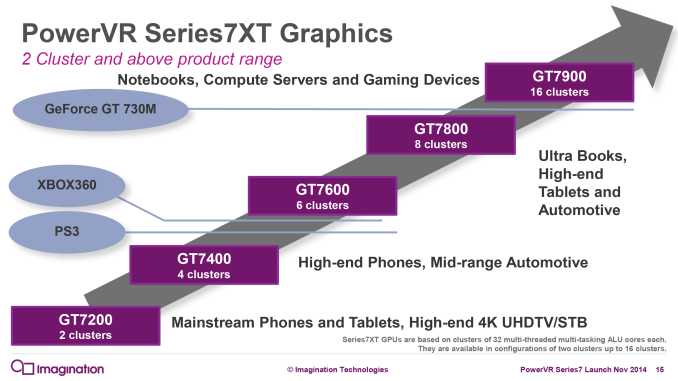
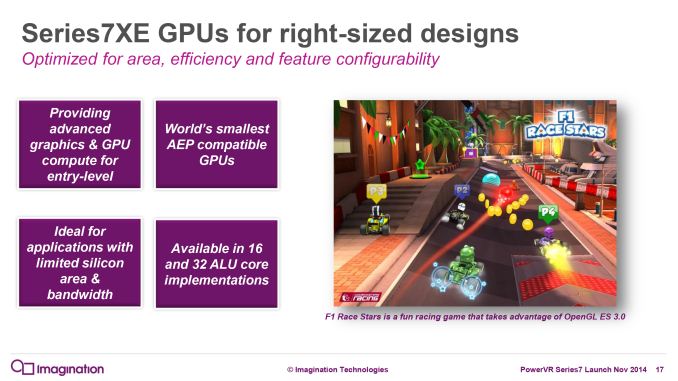
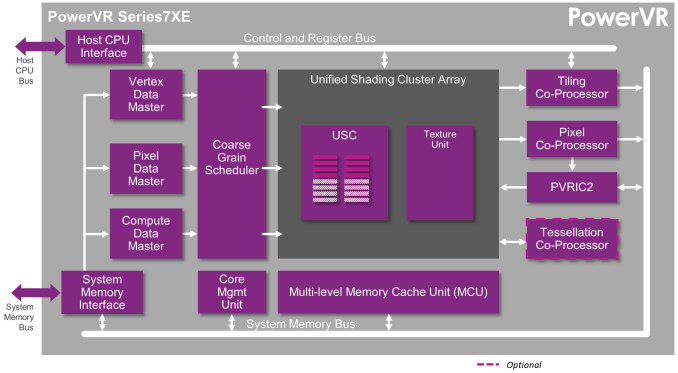
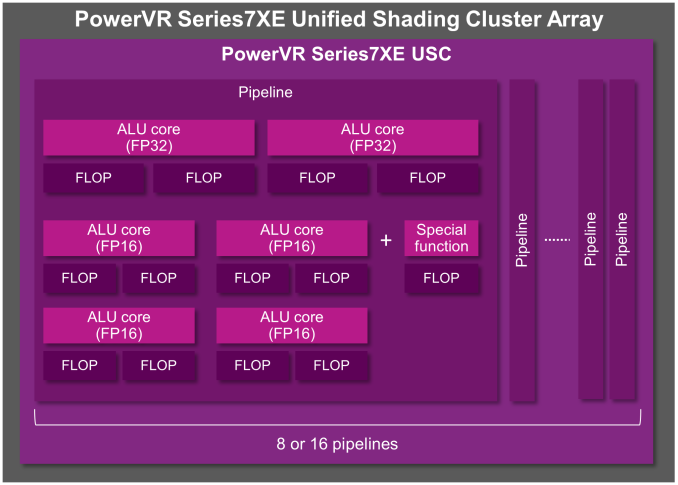
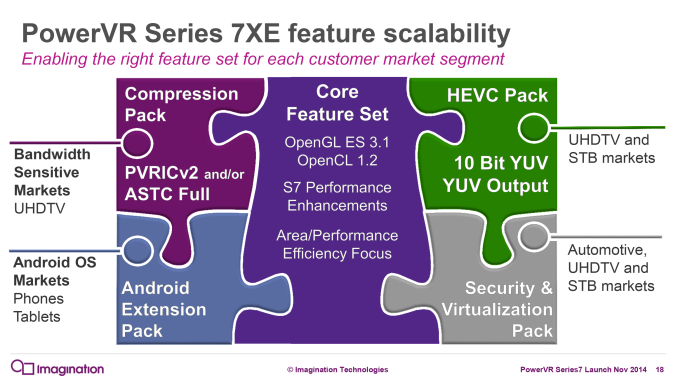









49 Comments
View All Comments
darkich - Monday, November 10, 2014 - link
I wonder why Samsung has dropped PowerVR for their Exynos in favor of Mali.From what we've seen in the last couple of years, Imagination GPU seem superior
Laxaa - Monday, November 10, 2014 - link
I would love to see this architecture used in a PS Vita successor. Too bad it will never happen.darkich - Monday, November 10, 2014 - link
600 GFLOPS on a, say, 720p 5.5" screen should easily allow close to PS4-level graphicsprzemo_li - Tuesday, November 11, 2014 - link
And sub hour times-on-batter => usless device.Can't do it!
PS/XO consume more then 200W
Smartphones are limited to 5W
So to make them equally strong smartphones gpus must be 50x more energy efficient!
darkich - Tuesday, November 11, 2014 - link
Newsflash..the technology is ADVANCING.And mobile (ultra low power) GPU technology is actually the fastest advancing technology so far.
The GX6650 reaches well over 300GFLOPS on a same TDP as GSX 543MP4 used to reach around 50GFLOPS in the Vita.
The Adreno 430 will reach over 250GFLOPS in 3W TDP, and will be out in smartphones in a few months.
And this PoverVR 7 series will probably reach 500GFLOPS in under 5W TDP.
przemo_li - Wednesday, November 12, 2014 - link
Can You defend that claim?What if we normalize it against used power.
Cause if we get FPS/W its not so rosy for mobile.
Reason is simple. Mobile GPUs also had biggest W budget increases! Bigger and bigger batteries meant that performance would not needed to be limited.
(Compared to dGPUs that have limited max W, which can not be passed)
So its:
Wats, node process, architectures VS node process, architectures.
(And mobile get better node processes quicker too!)
darkich - Tuesday, November 18, 2014 - link
Oh I wouldn't lay the claims out if I couldn't defend it.It is super easy and should really be obvious to anyone with some interest in mobile chips.
Here, behold the technological advancement.
http://www.gsmarena.com/samsung_galaxy_alpha_vs_on...
The Alpha has smaller battery, same sized screen of same resolution, yet it's GPU is on average 8 TIMES faster.
And the cherry on top - go for battery endurance comparison between the two.
And check this one
http://www.gsmarena.com/compare.php3?idPhone1=4620...
iPad Air 2 has only 50% battery, same sized screen and resolution, and its GPU is approximately 5 TIMES more powerful.
Battery endurance?
Basically the same.
How about this one?
http://www.gsmarena.com/compare.php3?idPhone1=5665...
Note 3 with the bigger and far more dense screen and almost equal battery capacity actually improves on the endurance.
But the real kicker - its Adreno 330 can do 158 GFLOPS, compared to Note 2's 20 GFLOPS!
I could go on and on.
Of course, the process difference plays its part but the architectural efficiency improvements are much greater (for example Mali T8xx and PowerVR series 7 designs this year are bringing yet another 40% and 60% efficiency improvements in the SAME process and clock speed compared to previous generation).
And overall advancement in mobile GPU fps per watt is nothing short of unprecedented.
Ps. sorry about the late reply
darkich - Tuesday, November 18, 2014 - link
Correction.. IPad Air 2 has more than 10 times (probably around 15 times a) ster GPU than iPad 3, and about 5 times faster than the iPad 4.asendra - Monday, November 10, 2014 - link
A ~50% improvement, combined with a node shrink, is nothing to sneeze at. I really though we would be stopping the enormous yearly improvements by now. Glad I was wrong!What a beasts will be next years ipads and iphones.
asendra - Monday, November 10, 2014 - link
This thing should be very close if not better than Intel HD 5000, which are the current macbook airs gpu.That should give intel a lot to think about.